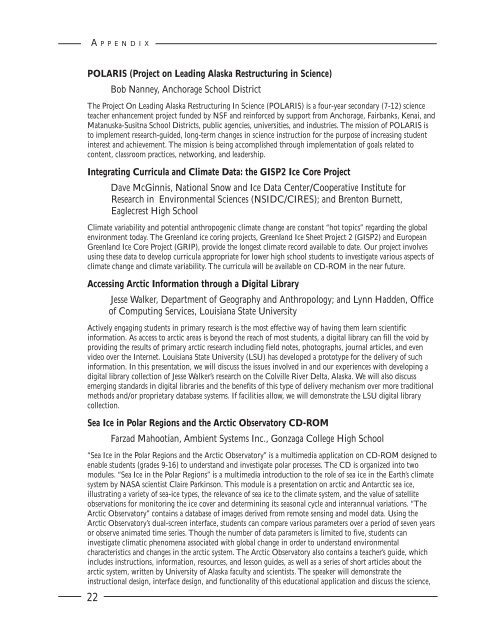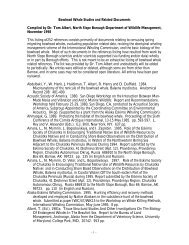ed report 4 page cover - Arctic Research Consortium of the United ...
ed report 4 page cover - Arctic Research Consortium of the United ...
ed report 4 page cover - Arctic Research Consortium of the United ...
You also want an ePaper? Increase the reach of your titles
YUMPU automatically turns print PDFs into web optimized ePapers that Google loves.
A P P E N D I X<br />
POLARIS (Project on Leading Alaska Restructuring in Science)<br />
Bob Nanney, Anchorage School District<br />
The Project On Leading Alaska Restructuring In Science (POLARIS) is a four-year secondary (7-12) science<br />
teacher enhancement project fund<strong>ed</strong> by NSF and reinforc<strong>ed</strong> by support from Anchorage, Fairbanks, Kenai, and<br />
Matanuska-Susitna School Districts, public agencies, universities, and industries. The mission <strong>of</strong> POLARIS is<br />
to implement research-guid<strong>ed</strong>, long-term changes in science instruction for <strong>the</strong> purpose <strong>of</strong> increasing student<br />
interest and achievement. The mission is being accomplish<strong>ed</strong> through implementation <strong>of</strong> goals relat<strong>ed</strong> to<br />
content, classroom practices, networking, and leadership.<br />
Integrating Curricula and Climate Data: <strong>the</strong> GISP2 Ice Core Project<br />
Dave McGinnis, National Snow and Ice Data Center/Cooperative Institute for<br />
<strong>Research</strong> in Environmental Sciences (NSIDC/CIRES); and Brenton Burnett,<br />
Eaglecrest High School<br />
Climate variability and potential anthropogenic climate change are constant “hot topics” regarding <strong>the</strong> global<br />
environment today. The Greenland ice coring projects, Greenland Ice Sheet Project 2 (GISP2) and European<br />
Greenland Ice Core Project (GRIP), provide <strong>the</strong> longest climate record available to date. Our project involves<br />
using <strong>the</strong>se data to develop curricula appropriate for lower high school students to investigate various aspects <strong>of</strong><br />
climate change and climate variability. The curricula will be available on CD-ROM in <strong>the</strong> near future.<br />
Accessing <strong>Arctic</strong> Information through a Digital Library<br />
Jesse Walker, Department <strong>of</strong> Geography and Anthropology; and Lynn Hadden, Office<br />
<strong>of</strong> Computing Services, Louisiana State University<br />
Actively engaging students in primary research is <strong>the</strong> most effective way <strong>of</strong> having <strong>the</strong>m learn scientific<br />
information. As access to arctic areas is beyond <strong>the</strong> reach <strong>of</strong> most students, a digital library can fill <strong>the</strong> void by<br />
providing <strong>the</strong> results <strong>of</strong> primary arctic research including field notes, photographs, journal articles, and even<br />
video over <strong>the</strong> Internet. Louisiana State University (LSU) has develop<strong>ed</strong> a prototype for <strong>the</strong> delivery <strong>of</strong> such<br />
information. In this presentation, we will discuss <strong>the</strong> issues involv<strong>ed</strong> in and our experiences with developing a<br />
digital library collection <strong>of</strong> Jesse Walker’s research on <strong>the</strong> Colville River Delta, Alaska. We will also discuss<br />
emerging standards in digital libraries and <strong>the</strong> benefits <strong>of</strong> this type <strong>of</strong> delivery mechanism over more traditional<br />
methods and/or proprietary database systems. If facilities allow, we will demonstrate <strong>the</strong> LSU digital library<br />
collection.<br />
Sea Ice in Polar Regions and <strong>the</strong> <strong>Arctic</strong> Observatory CD-ROM<br />
Farzad Mahootian, Ambient Systems Inc., Gonzaga College High School<br />
“Sea Ice in <strong>the</strong> Polar Regions and <strong>the</strong> <strong>Arctic</strong> Observatory” is a multim<strong>ed</strong>ia application on CD-ROM design<strong>ed</strong> to<br />
enable students (grades 9-16) to understand and investigate polar processes. The CD is organiz<strong>ed</strong> into two<br />
modules. “Sea Ice in <strong>the</strong> Polar Regions” is a multim<strong>ed</strong>ia introduction to <strong>the</strong> role <strong>of</strong> sea ice in <strong>the</strong> Earth’s climate<br />
system by NASA scientist Claire Parkinson. This module is a presentation on arctic and Antarctic sea ice,<br />
illustrating a variety <strong>of</strong> sea-ice types, <strong>the</strong> relevance <strong>of</strong> sea ice to <strong>the</strong> climate system, and <strong>the</strong> value <strong>of</strong> satellite<br />
observations for monitoring <strong>the</strong> ice <strong>cover</strong> and determining its seasonal cycle and interannual variations. “The<br />
<strong>Arctic</strong> Observatory” contains a database <strong>of</strong> images deriv<strong>ed</strong> from remote sensing and model data. Using <strong>the</strong><br />
<strong>Arctic</strong> Observatory’s dual-screen interface, students can compare various parameters over a period <strong>of</strong> seven years<br />
or observe animat<strong>ed</strong> time series. Though <strong>the</strong> number <strong>of</strong> data parameters is limit<strong>ed</strong> to five, students can<br />
investigate climatic phenomena associat<strong>ed</strong> with global change in order to understand environmental<br />
characteristics and changes in <strong>the</strong> arctic system. The <strong>Arctic</strong> Observatory also contains a teacher’s guide, which<br />
includes instructions, information, resources, and lesson guides, as well as a series <strong>of</strong> short articles about <strong>the</strong><br />
arctic system, written by University <strong>of</strong> Alaska faculty and scientists. The speaker will demonstrate <strong>the</strong><br />
instructional design, interface design, and functionality <strong>of</strong> this <strong>ed</strong>ucational application and discuss <strong>the</strong> science,<br />
22




